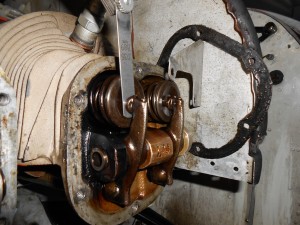 Under the Cowling
Under the Cowling
Valve Clearances and Hydraulic Lifters
Generally, most engine problems arise from incorrect amounts of fuel getting to the cylinders or lack of a hot spark from the ignition system at the proper time. These problems can usually be quickly resolved by cleaning a spark plug or injector, or by making timing or mixture adjustments. Occasionally, however, the internal parts of the engine and cylinders are at fault.
One of the best ways to check the internal health of the valve train is to check for the proper valve clearances on each cylinder. The minimum and maximum clearance is stated in the engine overhaul manual. The clearance (or valve lash) is checked by removing the valve covers and rotating the propeller by hand until the cylinder being checked is on its compression stroke. The valve clearance is then checked by inserting feeler gauges between the top of the valve stem and the rocker arm. To obtain an accurate reading the lifters need to be bled down. This is accomplished by gently (and repeatedly) depressing the rocker arm on the push rod side.
The camshaft is gear-driven by the crankshaft and has elliptically-shaped lobes that are machined with an incline across the top of the lobe. A tappet is a cylindrically-shaped body with a flat smoothly-machined face that rides on the cam lobe. The lobe is inclined so that the tappet spins as it is pushed up and down to prevent the tappet from contacting the camshaft lobe in the exact same place every time. If not for this design, such contact would eventually cause an indention on the tappet face.
The tappet body houses a hydraulic lifter assembly. The hydraulic lifter’s purpose is to use engine oil pressure to take up all the slack in the valve train as the engine is operating throughout its entire range. The hydraulic lifter consists of a cylindrical housing and a plunger backed by a spring at the top and a check valve at the bottom. The push rod seat rests on the plunger. Once the cam lobe pushes the tappet and its housed lifter up, the spring is depressed allowing oil to flow into the lifter. Since oil is not compressible, the lifter is then solid and the valve is opened as the top of the cam lobe rotates upward. As the high part of the cam lobe rotates away the lifter is lowered and the spring pressure is relaxed. This allows the check valve to open again so the valve can fully close. Leaky check valves, excessive wear between the plunger and cylinder of the lifter, and dirty oil can all effect the operation of a lifter. These can be hard to troubleshoot because often a valve will appear to open and close normally when pulled through by hand, but a faulty lifter can prevent proper valve operation when the engine is running.
The hydraulic lifer is seated against a push rod that transmits linear motion to a rocker arm and then directly to the valve itself, forcing it to open. Valve springs are very stiff springs used to keep valves closed until they are actuated by the rocker arms. Weak or broken valve springs can allow a valve to open too soon and close too late which causes a very rough-running engine.
Valve clearances that are too low are generally an indication that the valve face or seat in the cylinder has excessive wear. Clearances that are too high are generally a sign of excessive wear in the contacting surfaces of the valve train or a worn camshaft.
NOTE: Continental 85-hp and the O200 and O300 series engines have cylinders that are prone to valve seat wear and correspondingly sticking valves. The only fix is to replace the seats and valves, and it is becoming increasingly difficult to find facilities that replace valve seats. Most people simply swap out the affected cylinder.
Similarly, some Lycoming O235 engines use solid lifters, thus the valve clearances must be checked at more regular intervals than other engines.
Faulty lifters and weak valve springs can be difficult to troubleshoot since they don’t display signs of trouble until the engine is running, but valve wear can and should be periodically checked.


